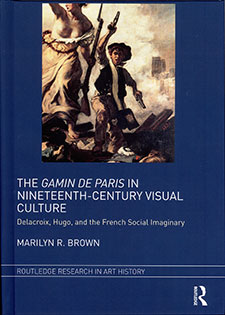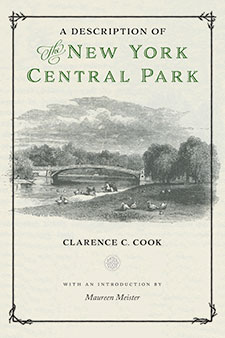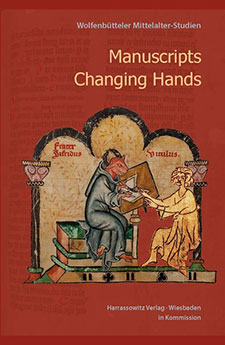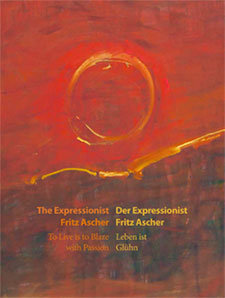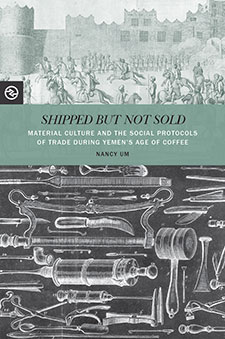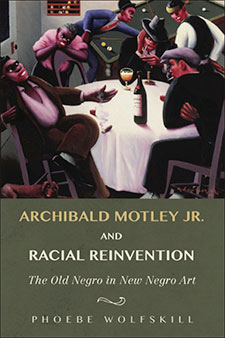CAA News Today
Exhibitions Curated by CAA Members
posted by CAA — Aug 16, 2017
Check out details on recent shows organized by CAA members who are also curators.
Exhibitions Curated by CAA Members is published every two months: in February, April, June, August, October, and December. To learn more about submitting a listing, please follow the instructions on the main Member News page.
August 2017
Ellen Carey. Women in Colour. Rubber Factory, New York, August 19–September 27, 2017.
Rachel Epp Buller. Crossing the Line. Mary Martin Gehman Art Gallery, Harrisonburg, Virginia, June 22–25, 2017.
Christine Giviskos. On the Prowl: Cats and Dogs in French Prints. Zimmerli Art Museum at Rutgers University, New Brunswick, New Jersey, September 5, 2017–January 7, 2018.
Donna Gustafson. Absence and Trace: The Dematerialized Image in Contemporary Art. Zimmerli Art Museum at Rutgers University, New Brunswick, New Jersey, September 5, 2017–January 7, 2018.
Donna Gustafson. Stanley Twardowicz: Color Field Paintings, 1962–1990. Zimmerli Art Museum at Rutgers University, New Brunswick, New Jersey, September 5, 2017–July 31, 2018.
Donna Gustafson. Subjective Objective: A Century of Social Photography. Zimmerli Art Museum at Rutgers University, New Brunswick, New Jersey, September 5, 2017–January 7, 2018.
Nancy Karrels. Provenance: A Forensic History of Art. Krannert Art Museum, University of Illinois, Urbana-Champaign, Illinois, May 13, 2017–June 9, 2018.
Nicole Simpson. Cats vs. Dogs: Illustrations for Children’s Literature. Zimmerli Art Museum at Rutgers University, New Brunswick, New Jersey, July 1, 2017–June 24, 2018.
Nicole Simpson. Serigraphy: The Rise of Screenprinting in America. Zimmerli Art Museum at Rutgers University, New Brunswick, New Jersey, September 5, 2017–February 11, 2018.
Rachel Stern. “Leben ist Glühn”: Der Expressionist Fritz Ascher / “To Live Is to Blaze with Passion”: The Expressionist Fritz Ascher. Museum Charlottenburg-Wilmersdorf in der Villa Oppenheim, Berlin, Germany, December 8, 2017–March 11, 2018; and Potsdam Museum—Forum für Kunst und Geschichte, Potsdam, Germany, December 10, 2017–March 11, 2018.
Karen Wilkin. “Beauteous Strivings”: Fritz Ascher, Works on Paper. New York Studio School, New York, October 23–December 3, 2017.
Books Published by CAA Members
posted by CAA — Aug 09, 2017
Publishing a book is a major milestone for artists and scholars—browse a list of recent titles below.
Books Published by CAA Members appears every two months: in February, April, June, August, October, and December. To learn more about submitting a listing, please follow the instructions on the main Member News page.
August 2017
David S. Areford. La nave e lo scheletro: Le stampe di Jacopo Rubieri alla Biblioteca Classense di Ravenna (Bologna: Bononia University Press, 2017).
Alexis L. Boylan. Ashcan Art, Whiteness, and the Unspectacular Man (New York: Bloomsbury Academic, 2017).
Marilyn R. Brown. The “Gamin de Paris” in Nineteenth-Century Visual Culture: Delacroix, Hugo, and the French Social Imaginary (New York: Routledge, 2017).
Clarence C. Cook. A Description of the New York Central Park, intro. Maureen Meister (New York: New York University Press, 2017).
Diana Gisolfi. Paolo Veronese and the Practice of Painting in Late Renaissance Venice (New Haven: Yale University Press, 2017).
D. Gustafson and A. M. Zervigón. Subjective Objective: A Century of Social Photography (Munich: Hirmer Verlag, 2017).
Rebecca Peabody. Consuming Stories: Kara Walker and the Imagining of American Race (Oakland: University of California Press, 2016).
Corine Schleif and Volker Schier, eds. Manuscripts Changing Hands (Wiesbaden, Germany: Harrassowitz, 2016).
Rachel Stern. The Expressionist Fritz Ascher: To Live Is to Blaze with Passion / Der Expressionist Fritz Ascher: Leben ist Glühn, ed. Ori Z. Soltes (Cologne: Wienand, 2016).
Athena Tacha. Visualizing the Universe: Athena Tacha’s Proposals for Public Art Commissions 1972–2012, ed. Richard E. Spear (Washington, DC: Grayson, 2017).
Nancy Um. Shipped but Not Sold: Material Culture and the Social Protocols of Trade during Yemen’s Age of Coffee (Honolulu: University of Hawai’i Press, 2017).
Phoebe Wolfskill. Archibald Motley Jr. and Racial Reinvention: The Old Negro in New Negro Art (Champaign: University of Illinois Press, 2017).
News from the Art and Academic Worlds
posted by Christopher Howard — Aug 09, 2017
Each week CAA News summarizes eight articles, published around the web, that CAA members may find interesting and useful in their professional and creative lives.
Professors as Targets of Internet Outrage
Many professors who have expressed their views about race and politics this year have found themselves targets of both the left and right. Nothing is too abstrusely academic, it seems, to seed an attack campaign fueled by websites that surveil social media to find gotcha-worthy gems. (Read more from the New York Times.)
Demands to Cancel Dana Schutz’s ICA Exhibit Don’t Help the Cause for Social Justice
A small group of Boston activists demand as much in their passionate opposition to the current Dana Schutz exhibition at ICA Boston. Should an artist be blacklisted and blocked from showing their work at museums around the nation because one of their recent paintings tackled the painful topic of the history of racial violence? (Read more from the National Coalition against Censorship.)
Upstart Co-Lab Wants Businesses to Hire More Artists
We’re used to the common narrative of the artist as someone so inspired that they simply can’t stomach a drab office job, preferring to ditch the cubicle for the white cube. And yet research has found that employers almost universally report creativity is of increasing importance in the “traditional” workplace. (Read more from Artsy.)
The Letters of Picasso’s Dealer and a Century’s Worth of Impressionist Archives Are Going Online
Art historians and dealers researching works of art will soon have a new trove of materials to work with, courtesy of the Wildenstein Plattner Institute. A century’s worth of documentation—stock books from galleries, artists’ correspondence, annotated sale catalogues—will be digitized to develop online catalogues raisonnés for Manet, Morisot, Monet, and more. (Read more from Artnet News.)
The Multifarious Book
A few years ago the director of a university press told me that her goal was “to save the monograph.” “Which one?” I responded. It was an impolitic remark, but it helped to make the point that books perform all kinds of tasks, and when we say we want to “save” the book, it is reasonable to ask if some of those tasks could usefully be performed in better, faster, and cheaper ways. (Read more from the Scholarly Kitchen.)
Cindy Sherman Takes Selfies (as Only She Could) on Instagram
For the most part artists use Instagram like the rest of us: as a document of everyday fascinations, a bit scrubbed up for public consumption. But Cindy Sherman—who knows more than most about the deceptions of selfies—has quietly been exploring Instagram’s potential for something more than self-promotion. (Read more from the New York Times.)
Performance Piece Featuring Witches Raises Questions at Seattle Art Fair
On Thursday evening, at the end of the first day of the Seattle Art Fair, I went on a witch hunt. Ten women wearing black hooded cloaks were wandering the aisles. Amid booths housing galleries from around the world, the dark figures walked, carrying battle axes, reading poetry, playing music, and taking pictures on their phones. (Read more from the Observer.)
Philippe de Montebello on How the Metropolitan Museum Can Reclaim Its Glory
Philippe de Montebello is an institution in his own right—as venerable and encyclopedic as would befit the Metropolitan Museum of Art, which he led for three decades. Recently, Artnet News’s editor-in-chief sat down with de Montebello to discuss the changes and opportunities at the Met, and his new role in the gallery world. (Read more from Artnet News.)
August 2017 Picks from CAA’s Committee on Women in the Arts
posted by CAA — Aug 01, 2017
Hương Ngô: To Name It is to See It
Firelei Báez: Vessels of Genealogies
DePaul Art Museum
935 W Fullerton, Chicago, IL
April 27–August 6, 2017
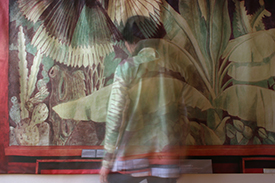
Hương Ngô, study for the video Hidden from Plain Sight, 2017 (artwork © Hương Ngô)
In concurrent exhibitions, the DePaul Art Museum presents Firelei Báez, Vessels of Genealogies, and Hương Ngô, To Name It is to See It. Báez, a Miami-based Dominican-American artist, is known for her use of textiles, patterns, and bright colors. She often depicts identity through the use of hairstyles and tattoos in her large-scale paintings, evoking both beauty and political implications “for those whose cultural identities have remained traditionally absent from dominant culture.” While Báez migrated to the United States, her work also addresses identity formation experienced by those who grew up in Latin, Caribbean, and African regions. She “challenges the basic idea of how race is experienced in the US—a condition defined as binary and black or white. In her work, one can appreciate that she is many cultures. She expresses the consciousness of a new generation eager to embrace their cultural prowess in terms of hybridity.”
In To Name It is to See It, Ngô, focuses on Vietnamese anticolonial organizer Nguyễn Thị Minh Khai. Ngô draws connections between language and seeing. The artist said, “‘To Name It Is To See It’ evokes the promise of a discursive practice, identifying an injustice by name is the first step to understanding it and working towards change. At the same time, there is deception to the title because identification was a preoccupation of the colonial authorities….” The exhibition by Ngô features more than twenty-five individual pieces of art ranging from photos to video and fabrics.
SaveArtSpace: The Future is Female
Through Summer 2017
Various locations throughout New York City
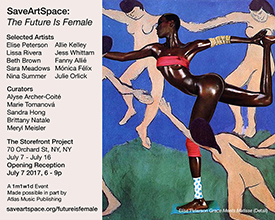 In this all-woman gallery and public art exhibition, The Future Is Female by SaveArtSpact features female artists on advertising spaces and billboards throughout the New York City area during summer 2017. The exhibit aims to expand upon the mainstream definition of “the female gaze” through works that reflect the multifaceted reality of womanhood in the twenty-first century and that expand upon society’s traditional ideals of femininity.
In this all-woman gallery and public art exhibition, The Future Is Female by SaveArtSpact features female artists on advertising spaces and billboards throughout the New York City area during summer 2017. The exhibit aims to expand upon the mainstream definition of “the female gaze” through works that reflect the multifaceted reality of womanhood in the twenty-first century and that expand upon society’s traditional ideals of femininity.
“One such woman is artist Elise Peterson,” writes Priscilla Frank in a HuffPost review, “whose piece Grace Meets Matisse injects a photographic image of Grace Jones into Henri Matisse’s 1910 Dance, placing her in the center of a ring of naked dancers. The image puts Jones’ black body into an image previously filled with white bodies, juxtaposing the flesh of the painted figures with the three-dimensional glow of Jones’ self-actualized body, mid-performance.” (http://www.huffingtonpost.com/entry/feminist-art-new-york-billboards_us_594abba7e4b0312cfb60fb92)
The work was curated by Meryl Meisler, Marie Tomanova, Alyse Archer-Coité, Sandra Hong, and Brittany Natale. In addition to Peterson, artists include Allie Kelley, Beth Brown, Fanny Allié, Jess Whittam, Julie Orlick, Lissa Rivera, Mónica Félix, Nina Summer, and Sara Meadows. Peterson’s work can be viewed in various locations throughout New York City, including Grand Street and Ludlow Street (343 Grand Street).
Jeanine Oleson
Commonwealth & Council
3006 W 7th St. Suite 220, Los Angeles, CA
July 8–August 19, 2017
The amplification of sound and image is at the center of Jeanine Oleson’s powerful exhibition at Commonwealth & Council. Using natural materials such as shell and glass within a performance-based lexicon, Oleson examines the effects of production under late capitalism, the meanings of community, and bodily experience. Three-dimensional imaging technology is employed to render visible what we already see but which we might not value; and elsewhere a transducer speaker made of shell expertly turns an object of childlike wonder into a proxy for political speech. Although not specifically positioned as a pendant to Oleson’s Hammer exhibition, concurrently on view, many of the interests in the two shows are similar, and benefit from a close read. At issue in both is how one might become a conductor—realizing the longing for a political elsewhere—using materials of the body and the world?
CUNT
Venus Over Los Angeles
601 S Anderson St, Los Angeles, CA
July 15–September 2
Although more iconographic than strictly historical, this group exhibition brings together six feminist artists who address the visuality of female bodies and their attendant sexualities. Betty Thompkins, Carolee Schneemann, VALIE EXPORT, Judith Bernstein, Dorothy Iannone, and Marilyn Minter may each depict the vulvic, but their similarities end there. Iannone’s confessional work, I Was Thinking of You (1975/2006), displays a video of artist’s face while she masturbates, housed in a lovingly decorated cabinet which recounts an old story of love and abuse (the text on the cabinet’s exterior begins: “You walk into my quarters 2000 years ago which are outside the city gates….”) The exhibition features new work by some of the artists—most notably a large black-light mural by Bernstein, in which a giant limp phallus covered in swastikas comes to stand for the “Trumpery” of America’s current political hierarchy. Nearby, a vagina dentata seems to be growing out of the official seal of the United States. It is a caustic and damning work—one filled with heaps of rage and anger—revealing why explicitness in our lives, politics, and art are as necessary as ever.
As in Nature: Helen Frankenthaler Paintings
225 South Street
Williamstown, MA 01267
July 1–October 9, 2017
As in Nature: Helen Frankenthaler Paintings presents twelve of this major Abstract Expressionist artist’s large-scale paintings. Made over the course of her long career, these works explore the tension between abstraction and representation and demonstrate her engagement with the landscape painting tradition. In particular, she found inspiration in the idyllic, wooded landscapes of the northeastern United States, home of the Clark Art Institute. Spanning the full range of styles, techniques, and formal preoccupations that Frankenthaler explored over five decades of work, these paintings are primarily abstract, yet reveal recognizable elements from the landscape that function, paradoxically, to reinforce their abstraction: as in nature, but not as in nature. As she said of one of her most iconic paintings, Mountain and Sea (1952), “The landscapes were in my arms as I did it. I didn’t realize all that I was doing. I was trying to get at something—I didn’t know what until it was manifest.”
A publication, authored by guest curator Alexandra Schwartz, with contributions by Christina Kee, accompanies this exhibition.
Marina Abramović: The Cleaner
Gammel Strandvej 13
DK 3050 Humlebaek, Denmark, Copenhagen
June 17–October 22, 2017
This summer, the Louisiana Museum of Art presents Marina Abramović: The Cleaner, the first major European retrospective presentation of this pioneering body and performance artist. The exhibition at Louisiana comprises more than one hundred works and spans more than five decades—from early concept sketches, paintings, and sound works to presentations of the artist’s performances—including her collaboration with former partner Ulay. Reperformances of an early work form part of the exhibition as well. The exhibition is structured chronologically, beginning with her Sound Corridor (War) of 1971, where the spectator is inundated with the sounds of gunfire, and ending with her quieter and more transformative works.
Marina Abramović: The Cleaner has been developed in a dialogue with the artist and is organized by Moderna Museet, Stockholm, in collaboration with the Louisiana Museum of Modern Art, Henie Onstad Kunstsenter, and Bundeskunsthalle, Bonn.
New in caa.reviews
posted by CAA — Jul 28, 2017
Kris Cohen visits Josh Kline: Freedom at the Portland Art Museum. “The first work in a projected five-work cycle,” Freedom imagines “a future that extends out from the present’s particular techno-economic landscapes.” The artist “takes the technologies and labor economies of neoliberalism not just as the context for his work but as the medium,” and the show is “far more esoteric than Kline admits.” Read the full review at caa.reviews.
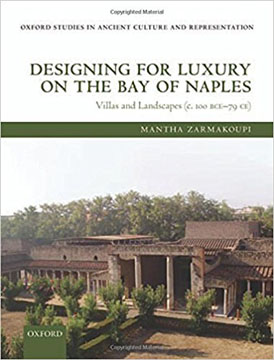 Elaine K. Gazda reads Designing for Luxury on the Bay of Naples: Villas and Landscapes (c. 100 BCE–79 CE) by Mantha Zarmakoupi. The author “argues that by appropriating selected elements of Hellenistic and Roman architecture designers created a new architectural language for Roman luxury villas.” The book’s “primary contribution” lies in its “analyses of the physical components of this language.” Read the full review at caa.reviews.
Elaine K. Gazda reads Designing for Luxury on the Bay of Naples: Villas and Landscapes (c. 100 BCE–79 CE) by Mantha Zarmakoupi. The author “argues that by appropriating selected elements of Hellenistic and Roman architecture designers created a new architectural language for Roman luxury villas.” The book’s “primary contribution” lies in its “analyses of the physical components of this language.” Read the full review at caa.reviews.
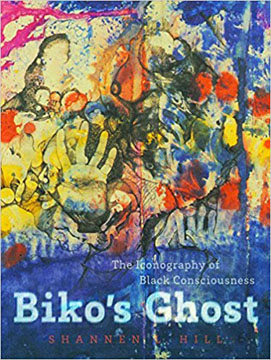 Jessica Stephenson reviews Shannen L. Hill’s Biko’s Ghost: The Iconography of Black Consciousness. The author “offers a convincing reconsideration of the contributions” that Black Consciousness and Stephen Biko’s “meaning and legacy” give “to a visual culture of liberation in South Africa.” Presenting “an impassioned redress,” she argues that this history has previously been marginalized and willfully misread. Read the full review at caa.reviews.
Jessica Stephenson reviews Shannen L. Hill’s Biko’s Ghost: The Iconography of Black Consciousness. The author “offers a convincing reconsideration of the contributions” that Black Consciousness and Stephen Biko’s “meaning and legacy” give “to a visual culture of liberation in South Africa.” Presenting “an impassioned redress,” she argues that this history has previously been marginalized and willfully misread. Read the full review at caa.reviews.
Affiliated Society News for July 2017
posted by CAA — Jul 18, 2017
Association for Critical Race Art History (ACRAH)
The Association for Critical Race Art History’s Bibliographic resource launched on January 9, 2017, and received over one thousand hits on the first day. In conjunction with the publication of the bibliography, reading groups were formed in the San Francisco Bay Area, Boston, New York, and Washington, DC, to bring together art historians engaged with issues of the representation of race and ethnicity and their histories. To date, forty-two people have participated in the reading groups, which have covered a wide array of topics including hybridity, empire, borders, primitivisms, and the contemporary status of identity politics. The reading groups were organized by Caitlin Beach (New York), Layla Bermeo (Boston), Margarita Karasoulas (Washington, DC), Marci Kwon (Bay Area), and Sean Nesselrode Moncada (New York). The organizers would like to thank Jacqueline Francis and Camara Dia Holloway, cofounders of the Association for Critical Race Art History, for their support and guidance in this endeavor.
Association for Latin American Art (ALAA)
The Association of Latin American Art announces its Eighteenth Annual Book Award for the best scholarly book published on the art of Latin America from the pre-Columbian era to the present. The award is generously funded by the Arvey Foundation and consists of a citation and a $1,000 honorarium. We will present the award at the CAA Annual Conference in Los Angeles, February, 21–24, 2018. The name of the recipient will appear in the newsletters of both ALAA and CAA. Visit our website for more information.
Association of Historians of American Art (AHAA)
AHAA announces the June 2017 publication of its ejournal Panorama, issue 3.1. Published twice a year, Panorama is the first peer-reviewed electronic publication dedicated to American art and visual culture from the colonial period to the present day. In addition to peer-reviewed scholarly articles, Panorama publishes Book Reviews, Exhibition Reviews, and shorter Research Notes, and features The Bully Pulpit. Subscribe for FREE here.
AHAA members received 2017 Awards for Excellence from the Association of Art Museum Curators. A publication award went to Melissa Wolfe, Curator of American Art, Saint Louis Art Museum, for Subversion & Surrealism in the Art of Honoré Sharrer at the Columbus Museum of Art. An exhibition award went to Kristina Wilson, Associate Professor of Art History, and Chair, Department of Visual and Performing Arts, Clark University for Cyanotypes: Photography’s Blue Period at the Worcester Art Museum.
AHAA announces its CAA 2018 session “America is (Still) Hard to See.” The program addresses where American art history sits in our twenty-first-century classrooms, galleries, museums, blogs, and journals and directions for its future growth. Speakers include: Kathryn Bunn-Marcuse, University of Washington; Kristine K. Ronan, independent scholar; and Rachel Stephens, University of Alabama. Distinguished scholar Erika Doss, University of Notre Dame, is the discussant.
AHAA’s Fourth Biennial Symposium will be held in October 2018 in Minneapolis, Minnesota (dates TBD).
AHAA’s mission is to promote scholarship on art of the United States through museum-based or theoretically oriented topics, whether regionally focused or offering broad historical sweep, by emerging and established scholars. The organization provides a forum for presenting and advancing new approaches; for examining problems that confront the field; and for identifying scholarly needs and opportunities to its members. Join today!
Association of Print Scholars (APS)
The Association of Print Scholars (APS) recently awarded the 2017 Schulman and Bullard Article Prize to Jonas Beyer of the Department of Art History at the Georg-August-Universität in Göttingen, Germany. Now in its third year, the prize recognizes an article published by an early career scholar that features compelling and innovative research on prints or printmaking. Beyer’s article, “Pictures in Flux: Degas’s monotypes and some notes on their relation to other media,” appeared in the book Perspectives on Degas, edited by Kathryn Brown and published in 2016. This is the first year that an article focusing on modern printmaking has won the award.
APS is pleased to announce that Anne Verplanck, associate professor of American studies at Penn State Harrisburg, has been elected as director-at-large for a three-year term.
During the recent Renaissance Society of America Conference, APS hosted a reception at the Art Institute of Chicago’s Goldman Study Center, where members viewed early modern works on paper. APS is now an affiliated society of the Renaissance Society of America and will host two panels at the 2018 conference.
APS looks forward to hosting our affiliated-society panel at next year’s CAA Annual Conference in Los Angeles. The selection committee is pleased to announce Yasmin Amaratunga Railton of Sotheby’s Institute of Art in London as chair of the panel, titled “Now you see it, now you don’t: Materialism and Ephemeral Prints.”
Community College Professors of Art and Art History (CCPAAH)
CCPAAH wants to thank all the presenters and participants at our affiliated session at the 2017 FATE Conference in Kansas City, Missouri. The panel “Draw and Repeat: Reconsidering the Sketchbook,” was chaired by Susan Altman, Middlesex County College and included the following presentations: “That’s Mine: Making the Sketchbook Personal” by Angus Galloway, University of West Georgia; “Reuse/Reclaim/Repurpose” by Eric Wold, Clark University; and “What’s in a Name? Renaming the Sketchbook” by Jon Hunt, Kansas State University. Everyone left with new ideas to bring back to their studio classrooms.
CCPAAH will be sponsoring a session at CAA’s 2018 Annual Conference in Los Angeles. The call for papers for “Championing the Relevancy of Studio Art and Art History in the Twenty-First Century: Stories of Success and Advocacy,” next year’s affiliated-society session at the CAA conference, was posted to the CAA website on June 30, with a submission deadline of August 14, 2017. Please consider submitting a proposal for this session. Interested in getting more involved with CCPAAH? Contact Susan Altman.
FATE (Foundations in Art: Theory and Education)
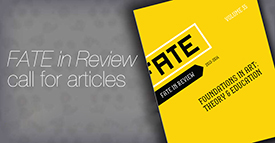 Episodes 10, 11, and 12 of “Positive Space,” FATE’s monthly podcast are now available. FATE Educator Award Winner, M. Michelle Illuminato, and FATE Shout Out Award Winner, Ralph Pugay, discuss rebuilding foundations at Portland State University, community engagement, creating welcoming learning environments and how to encourage students to be present in the creative process. FATE Educator Award Winner, Rae Goodwin discusses “Failing Forward” in her own work and how that influences her teaching and interactions with students, and FATE Leadership Award Winner, Scott Betz, discusses mentorship, creativity, and how teaching informs his ability to lead people both inside and outside the classroom. More info on the Positive Space webpage, and you can listen on iTunes.
Episodes 10, 11, and 12 of “Positive Space,” FATE’s monthly podcast are now available. FATE Educator Award Winner, M. Michelle Illuminato, and FATE Shout Out Award Winner, Ralph Pugay, discuss rebuilding foundations at Portland State University, community engagement, creating welcoming learning environments and how to encourage students to be present in the creative process. FATE Educator Award Winner, Rae Goodwin discusses “Failing Forward” in her own work and how that influences her teaching and interactions with students, and FATE Leadership Award Winner, Scott Betz, discusses mentorship, creativity, and how teaching informs his ability to lead people both inside and outside the classroom. More info on the Positive Space webpage, and you can listen on iTunes.
In addition, FATE in Review seeks thoughtful articles relating to all areas of foundations education, including expanding the practicum, flexing the core, and re-visioning visual culture. Conference papers and/or presentations, as well as papers written solely for publication, may be submitted throughout the year. We are also interested in reviews of newer books that inform foundations discussion and curriculum. Contact FATE in Review Editor, Michael Marks.
Upcoming for CAA 2018: FATE’s CAA affiliate representative, Naomi J. Falk, is looking for panelists for FATE’s affiliate conference session, entitled, “Let’s Dance, But Don’t Call Me Baby: Dialogue, Empathy, and Inclusion in the Classroom and Beyond.” Feeling welcome, acknowledged, and heard encourages learning. Fostering inclusiveness and empathy on behalf of minority students legitimizes perspectives. How do we build trust and empathy between faculty, students, peers, and others in our classrooms and communities? How do we create a welcoming and inclusive environment? What has worked? What has gone terribly wrong? Where do we go from here? Examples of readings, projects, tools, and exercises for building inclusive, encouraging, and productive dialogues are all of interest. Please contact: Naomi J. Falk.
Japan Art History Forum (JAHF)
The Japan Art History Forum is pleased to announce that it will hold its first competition to award the JAHF First Book Subvention Prize this year. This prize will be awarded once a year to a book project that will make a substantial contribution to the field of Japanese art history, broadly defined. The award is for a maximum of $2,000, provided from membership dues and donations to the Japan Art History Forum. The deadline for submission is September 15, 2017. Visit our website for more information.
National Council of Arts Administrators (NCAA)
The forty-fifth National Council of Arts Administrators (NCAA) annual gathering, “Ground | Work: Producing Access and Equity in the Arts,” convenes September 20–23, 2017, hosted by the University of Arizona School of Art in Tucson. The lineup of speakers promises to be dynamic and engaging and includes the artist Wafaa Bilal and keynote speaker Alfredo Jaar. We have a wide range of presentations and activities arranged around this year’s conference theme: “Ground | Work: Producing Access and Equity in the Arts.” We invite current and aspiring art-department chairs, directors, and deans to attend. Visit the website to learn more about the conference, member benefits, and to join NCAA.
Public Art Dialogue (PAD)
Public Art Dialogue welcomes five new board members: Annie Dell’Aria, Leslie Markle, and Andrew Wasserman, are PAD’s new program committee. Laura Holzman joins PAD’s social media team, and Ciara McKeown joins the PAD board as member at large. We’d like to thank our former program committee members, Norie Sato and Renee Piechocki for doing such a terrific job.
In other PAD news, co-chairs Cameron Cartiere and Jennifer Wingate have succeeded Cher Knight and Harriet Senie as co-editors of the journal Public Art Dialogue, and Erica Doss has taken over the position of book editor from Patricia Phillips. The fall 2017 issue will be the new editors’ first. All at PAD are grateful for Cher Knight and Harriet Senie’s stewardship as founding co-chairs of the organizations and as founding editors of the journal, and we also thank Patricia Phillips for her contributions as PAD’s book editor.
Please see CAA’s Annual Conference call for papers for information about PAD’s session in Los Angeles, “Teachable Monuments,” chaired by Sierra Rooney and Harriet Senie. Also, see the Public Art Dialogue website for the call for articles for the Fall 2018 issue of Public Art Dialogue on the topic of “Public Art as Political Action.” The deadline is March 1, 2018.
The Feminist Art Project (TFAP)
The Feminist Art Project (TFAP) at Rutgers University is pleased to announce TFAP Add-a-Thon, a week-long initiative to expand the TFAP Calendar Archive of the contemporary feminist art movement. During July 24–30, 2017, TFAP invites the public to help in reaching the goal to add one thousand additional listings to the TFAP Calendar Archive—the only comprehensive, searchable, virtual, and physical repository of contemporary feminist art activities across varying media and from all over the world.
Participate by adding events to the online calendar during July 24–30. TFAP is looking for new listings to add from 2005 onward, such as exhibitions, films, lectures, performances, and publications, and classes, in or about all visual art media with feminist art content, feminist intent, or work by any individual woman or women of all gender expressions. So dig through your files for past, current, and future events! List your or your institution’s activities, or be a feminist archivist-activist by picking a smaller institution in your community, or a large university or museum, to focus on.
TFAP needs your catalogues, announcements, and other documentation that mirror the Calendar Archive listings that you post. They will be included in the Miriam Schapiro Archives at Special Collections and University Archives at Rutgers University Libraries, where the TFAP Archive is housed. It is vital for us to continue to contribute to this archive to ensure that the activities of women artists are included in the historical record and creating a key resource for researchers and scholars who will study the feminist art movement in the future.
The TFAP Add-a-Thon is presented in partnership with Special Collections and University Archives, Rutgers University Libraries. Visit feministartproject.rutgers.edu for more information about the TFAP Add-a-Thon and sending your archive materials.
Lev Manovich in Conversation with Hunter O’Hanian
posted by michaelh — Jul 18, 2017
—Lev Manovich on living in Chelsea
| Hunter O’Hanian: | Hello everyone, I’m Hunter O’Hanian and I’m the Director of the College Art Association, and I’m here today to chat with Lev Manovich. Hello Lev. How are you? |
| Lev Manovich: | Great. |
| Hunter O’Hanian: | Yeah. Nice to see you. Thank you for welcoming us to your home here in Chelsea, in New York. |
| Lev Manovich: | I’m honored. |
| Hunter O’Hanian: | Well, it’s great to be here. It’s great to be out on the roof of your house and how long have you lived in this neighborhood in New York? |
| Lev Manovich: | Before I was a professor in the art department of University of California, San Diego, between 1996-2013 when I was offered the job as a professor for the Graduate Center CUNY, I rented this place and I love it because all the blue-chip galleries are right next door. If I want, I can go in my pajamas to the Gagosian or Pace. |
| Hunter O’Hanian: | How great that you just get to go out in your pajamas and go to Pace, or Gagosian or wherever. Okay, so you got your PhD from the University of Rochester. You got your MA from NYU, you got your BA from there as well, too. What I think is really interesting is that you have degree from the Moscow Institute of Architecture that you got in 1977 and ‘79. In addition, you’ve won many awards including the Mellon Fellowship in Art Criticism, you won a Guggenheim in 2003. |
| Let’s circle back to your time in Moscow. What was that like? When you were there, Leonid Brezhnev was the head of the Soviet Union. What was that like as a young scholar? | |
| Lev Manovich: | 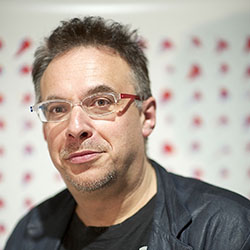 When I left in the early ‘80s, I was 21. I wasn’t a scholar yet. So, I didn’t get to finish with the Institute. I would have spent two more years. I grew up in the ‘70s, which was the final phase of the Soviet Union and the whole Communist system, and looking back I am so, so glad that I grew up out of this crazy different planet. Because here, when you come to the States, especially at that time, everything was so different. When I left in the early ‘80s, I was 21. I wasn’t a scholar yet. So, I didn’t get to finish with the Institute. I would have spent two more years. I grew up in the ‘70s, which was the final phase of the Soviet Union and the whole Communist system, and looking back I am so, so glad that I grew up out of this crazy different planet. Because here, when you come to the States, especially at that time, everything was so different.
I think this experience of growing up there is completely responsible for my whole career. Because I think when I look at contemporary, let’s say culture, since that time, because of … and capitalism, and that really became dominant worldwide, I have my alien perspective. I think it helps me to see things in very strange ways. Another thing, which, of course, I miss a lot … during the time everything was forbidden, people published things in Samizdat, you couldn’t buy foreign books in bookstores, but people were still able to do independent culture. People would have exhibitions of art in their apartment. Somebody would call you and say, “Go to this apartment,” and the exhibition would last five hours. Because everything was forbidden, when people were able to do something like this, you knew when to go to them, everybody just felt so excited. |
| Hunter O’Hanian: | Sure. |
| Lev Manovich: | Whereas today, I think we have abundance of information, opportunities, exhibitions…. There are so many galleries in New York. There are hundreds of art being noticed. You can follow any artist online and I am always surprised with my students who don’t take advantage of it. Because, for me, growing up in a country where there was information hunger. I love internet. I love Instagram. Basically, what I do before I go to sleep, I read Wikipedia. |
| With abundance of information, the fact that I can find out about so many things and I can also see what artists are creating in tens of thousands of cities around the world, from my computer, it’s absolutely amazing. |
| Hunter O’Hanian: | That’s wonderful. You’re now a professor to Graduate Center CUNY and you’re the Director of the Cultural Analytics Lab, which was founded in 2008. From what I’ve read, you developed the concept of cultural analytics in 2005. Tell us, what is cultural analytics? |
| Lev Manovich: | In the middle of 2000s, this new term “digital humanities” started to become more and more popular, and in this decade it has really been very widely discussed in my Academy. Just as today, at the time, people were starting to use computational tools to analyze, let’s say culture. Not looking at certain novels, but ten thousand novels, and there is a cultural scale…. The focus of this work has largely been literature. |
| When I saw it I said, “Well, we kind of need a different term to indicate, but we also want to apply these methods to study the history of culture, the history of art, history of visual media, and also contemporary media, whether it is web design, Instagram, photography.” I come up with a term and today there are hundreds of others’ papers, where people analyze, for example, social media or visual social media with papers done by people in Computer Science, Computational Social Science, Visual Anthropology, Visual History, and also recently merging to field of paradigm of visual history. | |
| I think what I started was, really, just a few papers and now I can use this term more like an umbrella to describe this research, which includes not only publications in academic journals, but also art projects, exhibitions, software people share online. Today research, the research outputs or research tools, also includes software data sets. Let’s say Google has this amazing cultural institute and curate these beautiful exhibitions of images. It’s also very cultural analytics. | |
| I would say its use of computation, not always to analyze. It’s a visual media or artistic media, but also to teach it and also to create new interfaces for interactive media. | |
| Hunter O’Hanian: | One of the research questions that you pose in the lab is, “How can we observe giant cultural universes of both user-generated and professional media content created today without reducing them to averages, outliers, or preexisting categories?” How has your research developed in that area? |
| Lev Manovich: | I think when I started, I was so fascinated with within a couple of years, the number of cultural producers and visual artifacts re-created, exploded a universe that grew after The Big Bang, so to speak. Let’s say, before, people were writing about Italian Renaissance or 1940s Hollywood cinema. Basically, we have a limited number of artifacts, limited number of artists, and you can kind of observe it, in a way, with your own eyes. In 2005, when people started sharing things on Flickr and on YouTube, and Instagram and Twitter and so on. Today, people are sharing over two billion images per day. |
| Hunter O’Hanian: | That’s amazing. Two billion a day. |
| Lev Manovich: | Yeah. It’s growing. |
| Hunter O’Hanian: | Wow, amazing. |
| Lev Manovich: | There is no way for you to observe it with your own eyes. I find this a great challenge but also find it was fascinating. The only way for me to see, for example, what was the different content people create, what are different styles? In the case of photography, what are photographic techniques? In a way, it’s like this invisible world because it’s too big. If I use something like telescope, microscope, I can only see so much. I said, “Well, it’s not like I like computers so much, I do; but I have to turn to computers, the techniques of computer science, just to be able to see what is out there.” |
| It’s particularly important if you don’t start with some preexisting categories. Because, let’s say you say, “Okay, I want to look at contemporary Instagram, using categories like Selfie, Portrait, Still Life,” but we don’t know what other genres are out there. We don’t know what kind of hybrid genres. I said, “As opposed to starting with particular categories and training the computer to find images in these categories, if I do it, I am only going to confirm what I already know.” | |
| For me, Cultural Analytics is basically about questioning everything we know, so using that challenge of big data to question what we know. I said, “What I actually want to do is not necessarily statistics but visualization, I want to sample this universe. I want to bring thousands or millions of images before my eyes.” Even I, myself, am going to see all kinds of interesting patterns, which perhaps don’t fit in these categories. It is really about observing in a very precise way. | |
| You can also connect it to workings of our history, Heinrich Wölfflin… created this new method, which our historians use throughout the century in comparing images on two slides. How you can compare billions of images? I see Cultural Analytics, in a way as an extension of comparative methods in humanities. | |
| Hunter O’Hanian: | You also look in the lab about how you use data to measure diversity, variability, differences in temporal changes in these cultural data sets. What are some conclusions you’ve drawn from that as well? |
| Lev Manovich: | We look at everything from cartoons, films, TV series, posters, book pages, Time magazine covers, one million Manga pages, one million artworks from DeviantArt, 50 million Instagram photos. I said, “So these are all very different types of visual culture.” If I’m to develop some methodology, which I can teach to students, in general, right, what we should look at? For example, if we look at visual art, we talk about topics, style, et cetera. If we’re looking at literature, we can look into other things. |
| Abstract from these media-specific categories, what else? I said, “Well, we could talk about how certain point of culture developed over time and we use computers that allow us to see, keep track of these changes. We can take different data sets and compare them.” For example, I want to compare a million paintings done in Brooklyn versus a million paintings done, I don’t know, in 798 in Beijing, but how do you compare those on a scale? | |
| When we can think about our ability … so you say, “Okay, there is a particular genre of selfie.” There are millions of selfies, which are very close or very far from the genre, so you think of a particular genre or a particular idiom. All right? Let’s say 19th century still life. When you consider it all works in terms of how close to the center it all is and finally because of diversity. We talk about the ability, it’s like statistics, right? How far a particular data point from average. With the ability, it’s more like ecology: how many different species of animals have you observed in this forest? | |
| Today if we observe, for example, something on Instagram, we’re not going to find a billion different species of images. We’ll maybe find 350, or maybe 1,000, or maybe 500. The same thing if you look at 19th Century painting or 16th Century art in China. Typically, our historians have been describing it in a very reductive way, saying, “Well, there’s four styles, there is four types.” What if I start saying, “Well, maybe it’s not four styles, maybe it’s 400 styles, or 40.” | |
| It’s not about throwing away categories, it’s gaining more categories. The way people do it in science, so biologists describe life on the earth, same with a hundred million species and be able to deal with it. What if I start dealing with 10,000 species of images? Why not, right? Basically, we’re bringing our reflection about using visual culture, a bit up to date to what is used. Actually, I will tell you, people able to look at things the more precise way, uniquely with distinctions. |
| Hunter O’Hanian: | Of course, using social media and a lot of the stuff that you do today, it’s great that you’re able to mix fine art and popular culture at the same time and the culture around everybody and bringing that in as to what their lives are about and you’re mixing those two things when you look at it. |
| Lev Manovich: | Well, I think it connects to another point, which we talked about right before we started. Today we have four billion mobile subscriptions. Not all of them are smartphones but there’s at least one billion people which have smartphones and they come with all this free software. Not only with, let’s say, again, but over 200 apps to aid images. Let’s say when I started doing digital art 30 years ago, you can put all the people who did digital art in one room. Then, let’s say, 20 years ago you could put them all … maybe 300 people. |
| Now, we have a billion people. The way we have one billion artists and one billion photographers and if you look closely you can find all kinds of things. You find things which are maybe very, let’s say, something or something will give a copy for somebody else, but you also find lots of diversity. What I want to do is I want to expose this diversity because I think, ultimately, if you’re to collect enough of a sample of contemporary art, perhaps you may find more diversity on social media because contemporary art you also have certain fashions, certain waves. | |
| Today we’ll have this in fashion, tomorrow … so we have this idea which comes from that … with art as something special, it’s a romantic, it’s the best of humanity, but today you don’t need to go to art school or design school to be artist and you can basically have viewers of your work on social media. | |
| Hunter O’Hanian: | Sure, and it creates an audience. |
| Lev Manovich: | Yeah, so I think intellectuals tend to dismiss it as something trivial, something banal, well, that’s not being intellectual. We want to take it seriously. |
| Hunter O’Hanian: | Yeah, no, that’s good. You brought Instagram up a few times. How many followers do you have on Instagram? |
| Lev Manovich: | Basically, last year I was writing this book about Instagram. I would observe something, write a chapter, I have those chapters on my website. When I do this research over about three years, I basically figure out some principles, whether it has to do with how many followers, but there are also thousands of articles about it. |
| My case, I didn’t follow those rules, so I only have a couple thousand followers. On Twitter, I also read about … I read, for example, research that says if you want to be retweeted, you have be between 110, 140 characters. I follow statistics even … to Tweet, so Twitter I follow all the rules so I have over 20,000. | |
| Hunter O’Hanian: | Wow. |
| Lev Manovich: | I follow the rules, but then of course, limited to what you can say. |
| Hunter O’Hanian: | Sure. Obviously you’re coming into contact with a lot of students these days and a lot of people who are either art makers or scholars or thinking about digital media. What kind of advice do you have for people entering the art world, whether they’re creative or whether they’re writing, what would you tell them? |
| Lev Manovich: | Well, I hope people are not entering the art world, I hope they’re entering the cultural world. |
| Hunter O’Hanian: | Interesting. |
| Lev Manovich: | The art world is just a very small part of it. To be honest, I don’t know a single person which takes the contemporary art world seriously. |
| Hunter O’Hanian: | Okay. |
| Lev Manovich: | Yeah, because again, in my view, fields like design, science and food are more interesting, but that’s my opinion. To be an artist in the art world, it’s not the only choice anymore. I think with people who are young, I would say there are two reasons why I would recommend people to learn computer programming and a bit about data. First of all, this is a world believer. Production analysis, algorithms based on data are central to the contemporary world, as electricity was central to the … century, as steam engines were central to industrial world of 1820. |
| If you simply want to understand the world in which you live, but why will Facebook … how does the navigation system in my car work? You should basically have some computer literacy, data literacy, and should learn something about algorithms, basic programming, how to make a webpage, analyze data, give statistics. Otherwise, I don’t know if you can say very relevant things about the world today. | |
| Maybe artists’ or historians’ culture. The second thing, I think, for professional advancement, so the digital humanities started in early 2000s, in the last five or six years you see many, many jobs where people want somebody who does 19th-Century novel or 18th-Century theater plus, plus, plus, plus digital humanities. In this decade and for the next decade, this is something which actually would help you to get a job because the new thing—everybody wants it and most people don’t do it. | |
| Simply from this very practical point of view, our digital art history is something that should exist or something that’s probably started to around 2012. It’s very new. It will get bigger the way it happened in English or in literature, so I think if you’re entering the history, (1) it’s too young. Take some online class, learn a bit of programming, and also learn about things which are specific to art history, how the computer looks at images. Learn about computer vision. | |
| Because regardless of whether you’re using it in your work, in five years when you’re interviewing people will be asking, Do you know that?” You still will be doing it. Again, it’s not about giving up the mind, it’s not about giving up theory. It’s not about giving up analytical thinking, but it’s simply adding contemporary methods to the methods inherited over the last 300 years. | |
| Hunter O’Hanian: | You’ve been to many CAA conferences and it’s been great that you’ve spoken. I hope you get to come to another one. Our next one will be in Los Angeles in February 2018, so I hope you can come to that one as well. |
| Lev Manovich: | I appreciate it very much. The first time I was at CAA, I was still a student. It was in 1990, it was in Seattle. I actually met a couple people who became my best friends. |
| Hunter O’Hanian: | Fabulous, I love that. |
| Lev Manovich: | I’m very lucky that now I’m in New York. It stays in New York every other year, so I always come. I’m on the panels. People have to realize, it’s amazing that CAA exists because in most countries you don’t have anything like this. You maybe only have 200 art historians in Switzerland or we don’t have this organization. The fact that this is organization, you bring us together, we’re at conferences, job placement, there are all kinds of things you can develop. |
| Yeah, maybe we always complain that every organization is bureaucratic but it’s fantastic that CAA exists. I wish you guys all the luck, and I think we all should support it and it’s up to us if we don’t say something, it’s up to us to put it there. This interview, it’s fantastic, an interesting project, it also makes it more visual and more interactive. | |
| Hunter O’Hanian: | Thank you. |
| Lev Manovich: | Thank you so much. |
| Hunter O’Hanian: | Thank you for this great view and for inviting us to your roof here. It’s really great. |
| Lev Manovich: | Come anytime. We’ll drink some beers. |
| Hunter O’Hanian: | Okay, thank you. I appreciate it. |
New in caa.reviews
posted by CAA — Jul 14, 2017
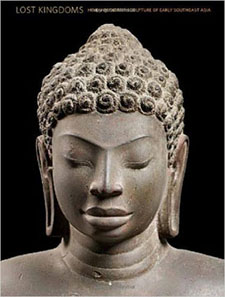 Emma Natalya Stein reviews the exhibition catalogue Lost Kingdoms: Hindu-Buddhist Sculpture of Early Southeast Asia, published by the Metropolitan Museum of Art. Representing “a watershed moment in the historiography of Southeast Asia, especially in terms of its relationship with India,” the “well-researched and beautifully illustrated catalogue” showcases “a truly remarkable body of material.” Read the full review at caa.reviews.
Emma Natalya Stein reviews the exhibition catalogue Lost Kingdoms: Hindu-Buddhist Sculpture of Early Southeast Asia, published by the Metropolitan Museum of Art. Representing “a watershed moment in the historiography of Southeast Asia, especially in terms of its relationship with India,” the “well-researched and beautifully illustrated catalogue” showcases “a truly remarkable body of material.” Read the full review at caa.reviews.
 Carmen Pérez González reads The Arab Imago: A Social History of Portrait Photography, 1860–1910 by Stephen Sheehi. The author aims “to ‘provincialize’ the history and ‘nature’ of photography,” and the “groundbreaking” volume “is an ambitious and theoretically challenging study, a significant and original work of social analysis of mostly unknown photographic material from the 1860s onwards.” Read the full review at caa.reviews.
Carmen Pérez González reads The Arab Imago: A Social History of Portrait Photography, 1860–1910 by Stephen Sheehi. The author aims “to ‘provincialize’ the history and ‘nature’ of photography,” and the “groundbreaking” volume “is an ambitious and theoretically challenging study, a significant and original work of social analysis of mostly unknown photographic material from the 1860s onwards.” Read the full review at caa.reviews.
News from the Art and Academic Worlds
posted by Christopher Howard — Jul 12, 2017
Each week CAA News summarizes eight articles, published around the web, that CAA members may find interesting and useful in their professional and creative lives.
Lessons from the Scaffold Controversy: “Museums Are Inherently Colonial Institutions”
It’s been just over a month since Minneapolis was hit with the Scaffold controversy. We asked several American curators to consider the controversy’s lessons for the larger museum world. Their responses set a new tone for how cultural institutions can work with local indigenous communities. (Read more from the Minneapolis Star Tribune.)
Falling in Love with a Felix Gonzalez-Torres Go-Go Dancer
It was the squeaking of the shoes that caught my attention. I knew exactly what was going on, and that the pale blue platform which I had seen empty a minute earlier was now occupied. I quietly rushed through the gallery to the small room where I saw him. Upon walking in, I froze and stared. (Read more from Hyperallergic.)
Thomas Campbell on Why He Stepped Down from the Met
I’ve moved the museum forward in many respects. We’ve modernized and come into the twenty-first century. We have an extraordinarily strong program. We’ve grown our audience by 40 percent. We’ve digitized. And we’ve done a lot of planning for the future. (Read more from the Art Newspaper.)
Most of a Mexican Museum Collection Fails Authentication
Almost all artifacts described as the oldest in the permanent collection of the Mexican Museum are either forgeries or cannot be authenticated to display in a national museum. That’s the finding of a report commissioned by the museum board and submitted in late June by Eduardo Pérez de Heredia Puente, an associate of the National Institute of Anthropology and History in Mexico City. (Read more from the San Francisco Gate.)
The Women Who Built the New York Art World
Over the course of ten years, between 1929 and 1939, four of New York City’s most iconic museums emerged: the Museum of Modern Art, the Whitney, the Frick Collection, and the Solomon R. Guggenheim Museum. These institutions are now world famous. But their founders—predominantly women—are relatively unknown. (Read more from Artsy.)
How to Chair a University Department and Not Be Terrible at It
This summer, I am completing a five-year stint as chair of my department. I know a lot more about chairing than I did when I took on the position, so I thought this might be a good time to share some lessons for those now taking on similar positions in their institutions or considering doing so in the future. (Read more from Pacific Standard.)
The Rise of the Thought Leader
The rich have empowered a new kind of thinker—the “thought leader”—at the expense of the much-fretted-over “public intellectual.” Whereas public intellectuals like Noam Chomsky or Martha Nussbaum are skeptical and analytical, thought leaders like Thomas Friedman and Sheryl Sandberg “develop their own singular lens to explain the world, and then proselytize that worldview to anyone within earshot.” (Read more from the New Republic.)
How to Build Your Own Career Fair
Career fairs pose special challenges for doctoral students and postdocs. Some people I advise describe feeling discouraged that the organizations they encounter at local career fairs are misaligned with their specific career interests. One reason is that the diversity of PhD programs in many institutions makes it impractical to bring together employers who appeal to a large portion of attendees. (Read more from Inside Higher Ed.)
Artists’ Legacies Unpacked in Art Journal
posted by CAA — Jul 05, 2017
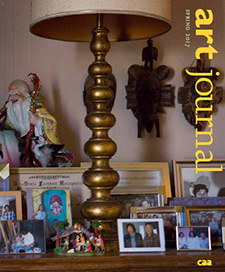 “What to do with all the stuff?” This is one of many questions posed—and provisionally answered—in the most recent issue of Art Journal, in an extensive multiauthor forum that delves into the complex matter of artists’ estates. “The Politics of Legacy,” guest-edited for the journal by Rachel Middleman and Anne Monahan, comprises contributions by no fewer than twenty-one artists and scholars. The texts include interviews (with, for example, Flavin and Rainer Judd, Mira Friedlaender, and Jane Kallir of Grandma Moses Properties, Inc.) and position papers (by Caroline A. Jones, Michael Corris, and Nancy J. Troy, among others). Central to the forum are three commissioned artists’ projects by Danh Vo (on the estate of Martin Wong), Mimi Gross (the estate of her father Chaim Gross, as well as her own legacy as an artist), and Jill Magid (the contested estate of the Mexican architect Luis Barragán).
“What to do with all the stuff?” This is one of many questions posed—and provisionally answered—in the most recent issue of Art Journal, in an extensive multiauthor forum that delves into the complex matter of artists’ estates. “The Politics of Legacy,” guest-edited for the journal by Rachel Middleman and Anne Monahan, comprises contributions by no fewer than twenty-one artists and scholars. The texts include interviews (with, for example, Flavin and Rainer Judd, Mira Friedlaender, and Jane Kallir of Grandma Moses Properties, Inc.) and position papers (by Caroline A. Jones, Michael Corris, and Nancy J. Troy, among others). Central to the forum are three commissioned artists’ projects by Danh Vo (on the estate of Martin Wong), Mimi Gross (the estate of her father Chaim Gross, as well as her own legacy as an artist), and Jill Magid (the contested estate of the Mexican architect Luis Barragán).
Elsewhere in the issue, editor-in-chief Rebecca Brown has selected three essays that deal with upheaval. Nazar Kozak details the interventions by Ukrainian artists during the 2013–14 uprising in Kyiv that brought down the nation’s government—artworks that at times literally became part of the armed barricade in the city’s central square. Sherry Buckberrough conjures the early twentieth-century context in which the Robert Delaunay created singular works with themes of androgyny, gender, and political violence. Sophie Landres explores sexual, corporeal, and musical interventions of the groundbreaking performances of Charlotte Moorman in late-1960s, as the new ideas of feminism reached the larger culture.
The issue marks the debut of reviews editor Kirsten Swenson, whose commissions explore books on Carolee Schneemann, on art in postwar South America, and on the trajectory of the choreographer Simone Forti. “The Prehistory of Exhibition History,” a critical bibliography by grupa o.k. (Julian Myers and Joanna Szupinska), completes the section.
CAA sends print copies of Art Journal to all institutional members and to those individuals who choose to receive the journal as a benefit of membership. The digital version at Taylor & Francis Online is currently available to all CAA individual members regardless of their print subscription choice.




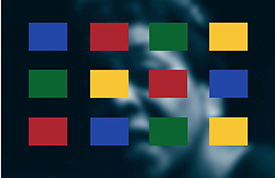 Carrie Mae Weems, Color Real and Imagined, 2004, archival pigment with silkscreened color blocks, 30 x 46 in. (artwork © Carrie Mae Weems)
Carrie Mae Weems, Color Real and Imagined, 2004, archival pigment with silkscreened color blocks, 30 x 46 in. (artwork © Carrie Mae Weems)

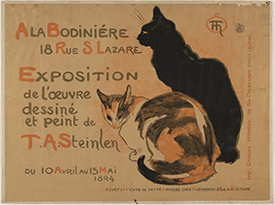 Théophile-Alexandre Steinlen, Exposition a la Bodiniere, 1894, lithograph. Collection Zimmerli Art Museum at Rutgers, gift of Mr. and Mrs. Herbert D. Schimmel (photograph by Peter Jacobs)
Théophile-Alexandre Steinlen, Exposition a la Bodiniere, 1894, lithograph. Collection Zimmerli Art Museum at Rutgers, gift of Mr. and Mrs. Herbert D. Schimmel (photograph by Peter Jacobs)
 Garry Winogrand, New York City, New York from the portfolio Women Are Better Than Men. Not Only Have They Survived, They Do Prevail., 1969, gelatin silver print, 8⅞ x 13¼ in. Collection Zimmerli Art Museum at Rutgers, gift of Varick D. Martin (artwork © Estate of Garry Winogrand; photograph by Bryan Whitney and provided by Fraenkel Gallery, San Francisco)
Garry Winogrand, New York City, New York from the portfolio Women Are Better Than Men. Not Only Have They Survived, They Do Prevail., 1969, gelatin silver print, 8⅞ x 13¼ in. Collection Zimmerli Art Museum at Rutgers, gift of Varick D. Martin (artwork © Estate of Garry Winogrand; photograph by Bryan Whitney and provided by Fraenkel Gallery, San Francisco)
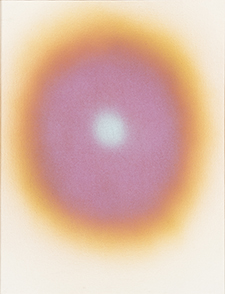 Stanley Twardowicz, Purple Circle, 1968, acrylic polymer on canvas, 25 11/16 × 19 13/16 in. Collection Zimmerli Art Museum at Rutgers University, gift of Benjamin Weiss (photograph by Peter Jacobs)
Stanley Twardowicz, Purple Circle, 1968, acrylic polymer on canvas, 25 11/16 × 19 13/16 in. Collection Zimmerli Art Museum at Rutgers University, gift of Benjamin Weiss (photograph by Peter Jacobs)
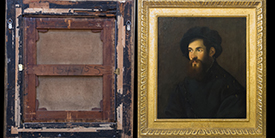 Moretto da Brescia (attributed), Portrait of an Unidentified Man, ca. 1525–50. Krannert Art Museum. Gift of Merle J. and Emily N. Trees (artwork in the public domain)
Moretto da Brescia (attributed), Portrait of an Unidentified Man, ca. 1525–50. Krannert Art Museum. Gift of Merle J. and Emily N. Trees (artwork in the public domain)
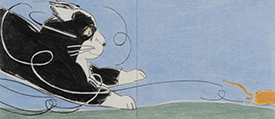 Ward Schumaker, Cat chases, illustration from Mouse Chase, ca. 1995, color pencil and graphite on tissue paper, 7⅛ x 16⅛ in. Collection Zimmerli Art Museum at Rutgers University, gift of the artist (photograph by Peter Jacobs)
Ward Schumaker, Cat chases, illustration from Mouse Chase, ca. 1995, color pencil and graphite on tissue paper, 7⅛ x 16⅛ in. Collection Zimmerli Art Museum at Rutgers University, gift of the artist (photograph by Peter Jacobs)
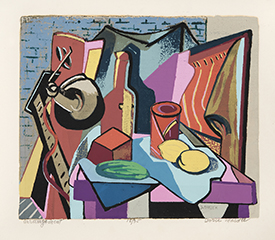 Dorie Marder, Arrangement, 1945, color screen print, 9¾ x 11 7/16 in. Collection Zimmerli Art Museum at Rutgers University, gift of Dr. David and Ruth Robinson Eisenberg (photograph by Peter Jacobs)
Dorie Marder, Arrangement, 1945, color screen print, 9¾ x 11 7/16 in. Collection Zimmerli Art Museum at Rutgers University, gift of Dr. David and Ruth Robinson Eisenberg (photograph by Peter Jacobs)




